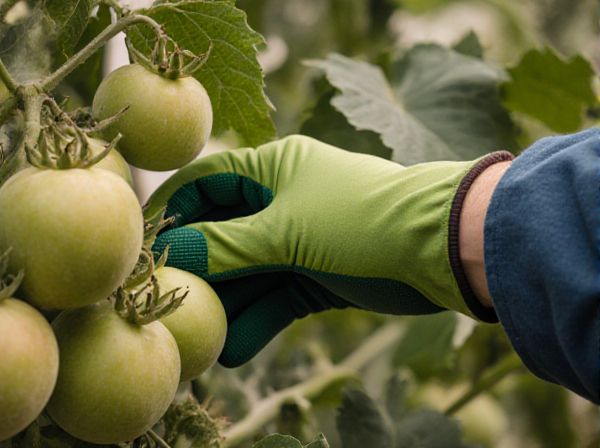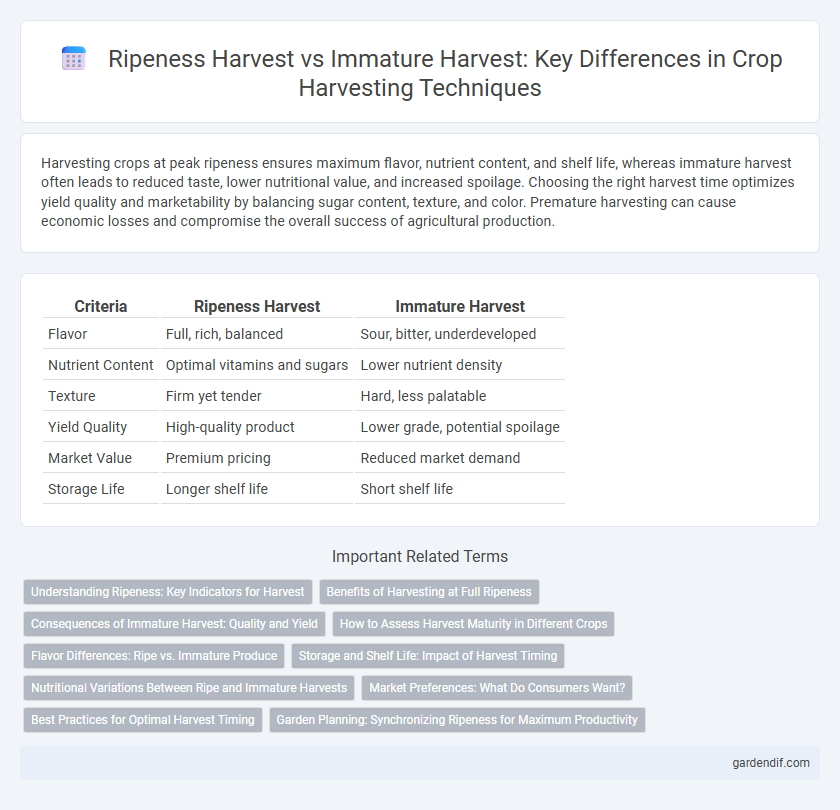
Ripeness Harvest vs Immature Harvest Illustration
Harvesting crops at peak ripeness ensures maximum flavor, nutrient content, and shelf life, whereas immature harvest often leads to reduced taste, lower nutritional value, and increased spoilage. Choosing the right harvest time optimizes yield quality and marketability by balancing sugar content, texture, and color. Premature harvesting can cause economic losses and compromise the overall success of agricultural production.
Table of Comparison
| Criteria | Ripeness Harvest | Immature Harvest |
|---|---|---|
| Flavor | Full, rich, balanced | Sour, bitter, underdeveloped |
| Nutrient Content | Optimal vitamins and sugars | Lower nutrient density |
| Texture | Firm yet tender | Hard, less palatable |
| Yield Quality | High-quality product | Lower grade, potential spoilage |
| Market Value | Premium pricing | Reduced market demand |
| Storage Life | Longer shelf life | Short shelf life |
Understanding Ripeness: Key Indicators for Harvest
Understanding ripeness involves analyzing key indicators such as sugar content, color, and firmness to determine the optimal harvest time. Ripeness harvest ensures maximum flavor, nutrient density, and storage longevity, while immature harvest results in lower quality, reduced taste, and increased susceptibility to spoilage. Measuring parameters like Brix degrees and acidity levels helps farmers achieve the perfect balance for peak crop quality and market value.
Benefits of Harvesting at Full Ripeness
Harvesting at full ripeness ensures maximum nutrient content, enhanced flavor, and optimal texture in fruits and crops, resulting in superior market value and consumer satisfaction. Fully ripened produce has higher sugar levels and essential antioxidants, which contribute to better health benefits and longer shelf life compared to immature harvest. Delaying harvest until peak ripeness also minimizes losses due to poor post-harvest quality and reduces the need for artificial ripening treatments.
Consequences of Immature Harvest: Quality and Yield
Harvesting crops before reaching full ripeness significantly reduces both quality and yield, leading to lower sugar content, diminished flavor profiles, and increased acidity in fruits and vegetables. Immature harvest results in smaller-sized produce with poor texture, making them more susceptible to spoilage and less marketable. Yield losses occur as underripe plants have not fully developed, causing a decrease in overall weight and volume collected during harvesting.
How to Assess Harvest Maturity in Different Crops
Assessing harvest maturity varies significantly among crops, requiring specific indicators such as color change in fruits like apples, dry down of grains like wheat, or firmness in vegetables like tomatoes. Tools like refractometers measure sugar content in grapes to determine optimal ripeness, while moisture meters assess dryness in cereals to prevent spoilage. Understanding crop-specific maturity signs ensures harvesting at peak quality, maximizing yield, flavor, and shelf life.
Flavor Differences: Ripe vs. Immature Produce
Ripe harvest yields produce with intensified natural sugars, balanced acidity, and fully developed aromatic compounds, resulting in optimal flavor profiles and sweetness. Immature harvest often produces underdeveloped flavors characterized by sourness, bitterness, and a lack of complexity due to incomplete biochemical maturation. Flavor differences between ripe and immature produce significantly affect culinary applications, consumer preference, and overall product quality in fresh markets and processed goods.
Storage and Shelf Life: Impact of Harvest Timing
Harvesting crops at optimal ripeness significantly enhances storage stability and extends shelf life by ensuring peak nutrient content and firmness. Immature harvests often lead to rapid spoilage and reduced market value due to underdeveloped sugars and cellular structure. Proper ripeness timing minimizes post-harvest losses, maintaining product quality and maximizing economic returns.
Nutritional Variations Between Ripe and Immature Harvests
Ripe harvests exhibit higher concentrations of essential vitamins such as vitamin C, beta-carotene, and antioxidants compared to immature harvests, which often contain elevated levels of antinutrients like tannins and phytates that reduce nutrient bioavailability. Sugar content and overall energy density increase significantly as crops reach full ripeness, enhancing both flavor and nutritional value. Enzymatic activity during ripening also improves the digestibility of proteins and carbohydrates, contributing to better nutrient absorption in humans.
Market Preferences: What Do Consumers Want?
Consumers overwhelmingly favor ripe harvests due to their superior flavor, texture, and nutritional value compared to immature harvests. Market analysis shows that ripe produce commands higher prices and enjoys greater shelf life, aligning with consumer demand for quality and freshness. Retailers and distributors prioritize ripe harvests to meet expectations for taste and appearance, driving market preferences.
Best Practices for Optimal Harvest Timing
Harvesting at peak ripeness ensures maximum flavor, nutrient content, and market value, while immature harvest often results in lower quality produce with reduced shelf life. Best practices for optimal harvest timing include monitoring fruit color, firmness, sugar content (Brix level), and days after flowering specific to each crop variety. Utilizing tools like refractometers and adhering to established maturity indices supports precise decision-making to enhance overall yield and product consistency.
Garden Planning: Synchronizing Ripeness for Maximum Productivity
Synchronizing ripeness during garden planning is essential for maximizing productivity by ensuring crops are harvested at peak maturity, which enhances flavor, nutrient content, and storage life. Harvesting immature crops often results in reduced yield quality and lower market value, negatively impacting overall garden efficiency. Strategic planting schedules and selecting varieties with uniform ripening periods optimize the harvest window, allowing for efficient labor and resource management.
Ripeness Harvest vs Immature Harvest Infographic

 gardendif.com
gardendif.com